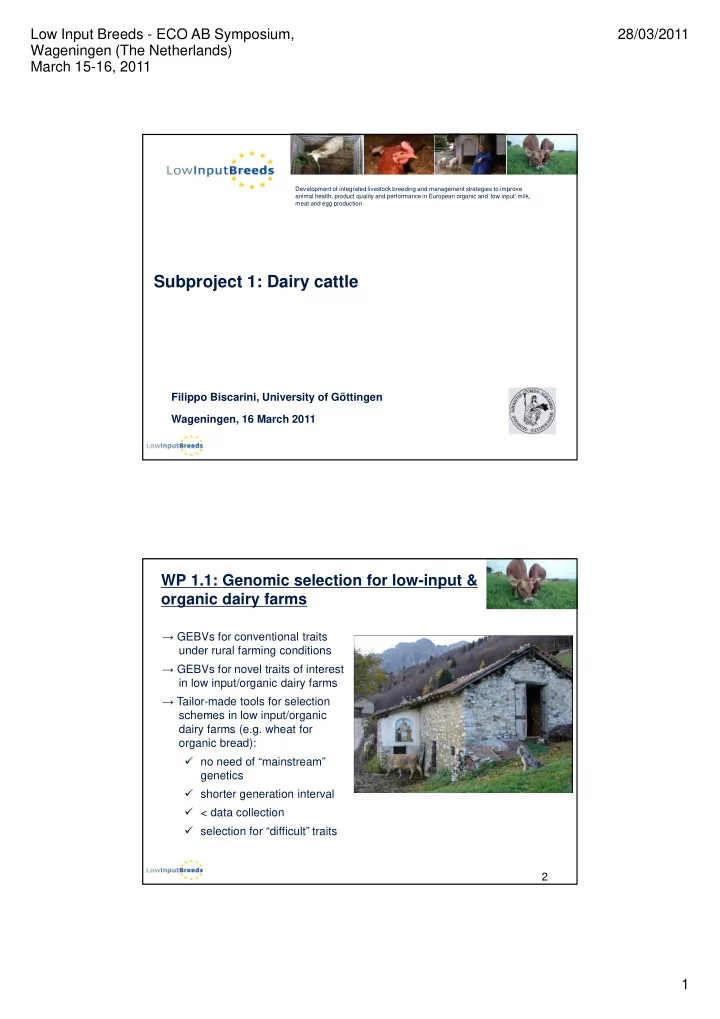

Low Input Breeds - ECO AB Symposium, 28/03/2011 Wageningen (The Netherlands) March 15-16, 2011 Development of integrated livestock breeding and management strategies to improve animal health, product quality and performance in European organic and ‘low input’ milk, meat and egg production Subproject 1: Dairy cattle Filippo Biscarini, University of Göttingen Wageningen, 16 March 2011 WP 1.1: Genomic selection for low-input & organic dairy farms → GEBVs for conventional traits under rural farming conditions → GEBVs for novel traits of interest in low input/organic dairy farms → Tailor-made tools for selection schemes in low input/organic dairy farms (e.g. wheat for organic bread): � no need of “mainstream” genetics � shorter generation interval � < data collection � selection for “difficult” traits 2 1
Low Input Breeds - ECO AB Symposium, 28/03/2011 Wageningen (The Netherlands) March 15-16, 2011 Material → ~ 1200 Swiss Brown cows in Switzerland are currently being genotyped and phenotyped → HD SNP chips (~800,000 SNPs) for some of the cows → routinary and unconventional phenotypes 3 In the meanwhile … • 1142 Swiss Brown bulls from national breeding programme in Switzerland • 54K chip SNP • EBVs for milk yield (high h 2 , 0.33) and non-return rate (low h 2 , 0.09) A number of approaches and methods for genomic selection are being tested 4 2
Low Input Breeds - ECO AB Symposium, 28/03/2011 Wageningen (The Netherlands) March 15-16, 2011 Methods 1. GBLUP : assumes constant variance for SNP effects • Genomic relationship matrix : Astle & Balding (2009), never applied to animal genetics • SNP regression for the estimation of SNP effects 2. Bayes C : allows variance to vary from marker to marker, many SNPs with no effect few with large effect (this proportion estimated from data) 5 Objectives • GBLUB (Astle & Balding) vs BayesC • EBVs vs DRPs (Rozzi & Schaffer, 1996) • High vs low h 2 • With vs without sex chromosomes All comparisons with cross-validation 6 3
Low Input Breeds - ECO AB Symposium, 28/03/2011 Wageningen (The Netherlands) March 15-16, 2011 Preliminary results: G-matrix Astle & Balding higher likelihood than other methods 7 Preliminary results: SNP effects 8 4
Low Input Breeds - ECO AB Symposium, 28/03/2011 Wageningen (The Netherlands) March 15-16, 2011 Preliminary results: accuracy of GEBVs • BayesC a bit better than GBLUP • EBVs better than DRPs • High h 2 better than low h 2 • No appreciable effect of markers on the sex chromosomes 9 Next steps The results of the work on genomic selection in bulls will later be applied to the cows genotyped and phenotyped under the LIB project • HD SNP chips • New phenotypes: health traits, fertility traits etc … • Is genomic selection in low-input conditions different than in intensive farming? • Is genomic selection a useful tool for low-input and organic farming? 10 5
Low Input Breeds - ECO AB Symposium, 28/03/2011 Wageningen (The Netherlands) March 15-16, 2011 WP 1.3: Breeding programme for low input & organic dairy cattle Brown Swiss cattle (~1200 cows, ~36000 records) low input farms in Switzerland (1.7 million hectares are grass: 1 million alpine pastures 0.7 million meadows and pastures) Variance and covariance components Heritabilities of production and reproduction traits Genetic correlations between milk yields and other production traits Genetic correlations between conception rates and corresponding test-day milk yields Parameters needed to design breeding programmes for low input herds 11 Available data 12 6
Low Input Breeds - ECO AB Symposium, 28/03/2011 Wageningen (The Netherlands) March 15-16, 2011 Methods • Random regression model • Legendre polynomials • E.g. h 2 production 0.8 0.7 traits 0.6 • Something alike MY 0.5 Fat% also for Pro% h 2 0.4 reproduction traits Lac% SCS 0.3 and genetic MUN 0.2 correlations 0.1 0 5 45 85 125 165 205 245 285 325 365 DIM 13 Results Apart from MUN, production traits have moderate to high heritabilities MY Fat% Pro% Lac% SCS MUN h 2 over DIM 0.39 0.39 0.56 0.50 0.21 0.18 Almost all fertility traits have low heritabilities CTFS DO CI GL NI CE SB h 2 over Parity 0.05 0.03 0.02 0.21 0.04 0.07 0.14 14 7
Low Input Breeds - ECO AB Symposium, 28/03/2011 Wageningen (The Netherlands) March 15-16, 2011 Discussion heritabilities in expected range (h 2 of production traits are higher than for reproduction • traits) positive genetic correlation between MY and Fat% in earliest stage of lactation the • mobilization of body fat reserves at the beginning of lactation negative genetic correlation between MY and SCS was found after DIM118 (also • Jamrozik et al., 2010; Samore et al., 2008) positive genetic correlation between MY and MUN (more energy for milk and less to • protein production � < protein � > MUN) negative genetic correlation (~ -0.7) between CR and MY (genetic selection for MY • would probably lead to a decrease in CR) Simulate daily observations of cows Set up suitable breeding programs 15 Hopefully … Low input breed project ≠ low output project ☺ ☺ ☺ ☺ 16 8
Low Input Breeds - ECO AB Symposium, 28/03/2011 Wageningen (The Netherlands) March 15-16, 2011 The authors gratefully acknowledge co-funding from the European Commission, under the Seventh Framework Programme for Research and Technological Development, for the Collaborative Project LowInputBreeds (Grant agreement No 222623) 17 9
Recommend
More recommend